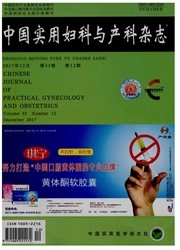

 中文摘要:
中文摘要:
目的探讨体外受精(IVF)周期中注射人绒毛膜促性腺激素(HCG)日不同血清雌二醇(E:)水平对新鲜周期及随后胚胎冻融移植(FET)周期妊娠结局的影响。方法对2008年1月至2010年12月在上海交通大学医学院附属瑞金医院生殖医学中心接受常规IVF或卵胞浆内单精子注射(ICSI)助孕的820个周期进行回顾性分析,根据注射HCG日血清E,水平分为6组:A组(〈7340pmol/1.),B组(7340~〈11010pmol/L),C组(11010一〈14680pmoL/L),D组(14680-〈18350pmol/L),E组(18350~〈22020pmol/L)和F组(≥22020pmol/L);为预防严重卵巢过度刺激综合征(OHSS)而放弃移植随后进行的首次FET周期,根据其取卵周期注射HCG日血清E,水平分为4组:I组(14680~〈18350prnol/L),Ⅱ组(18350~〈22020pmol/L),Ⅲ组(22020~〈25690pmol/L),Ⅳ组(~25690pmol/L),比较各组妊娠结局。结果随着E,水平的增加,受精率、卵裂率均呈增高趋势(P〈0.05);新鲜移植(ET)周期-临床妊娠率、种植率及继续妊娠率A、B组略低,C、D、E、F组较高,但各组比较差异均无统计学意义(P〉0.05)。全胚冻存后的首次FET周期,Ⅰ~Ⅳ组临床妊娠率、种植率和继续妊娠率差异无统计学意义(P〉0.05)。总FET周期临床妊娠率(51.09%)和种植率(31.68%)明显高于总ET周期(38.90%,25.32%)(P〈0.05)。结论促排卵周期中HCG日血清E,水平与IVF结局没有显著相关性,与随后FET结局也没有显著相关性。
 英文摘要:
英文摘要:
Objective To evaluate the effect of different estradiol ( E2 ) concentrations on the day of human choiionic gon- adotrophin (HCG) administration on pregnancy outcome of fresh IVF cycles and subsequent frozen-thawed embryo trans- fer cycles. Methods 820 IVF/ICSI cycles between January 2008 and December 2010 performed in Reproductive Medi- cine Center of RuiJin Hospital Affilited of Shanghui Jiaotong University. were evaluated retrospectively. Serum E2 concen- trations on the day of HCG administration were categoiized into six groups: group A ( 〈 7340pmol/L), group B (7340-〈ll010pmol/L), group C (ll010- 〈 14680 pmol/L), group D( 14680- 〈 18350 pmol/L), group E (18350 - 〈 22020 pmol/L)and group F ( ~〉 22020pmol/L). The first frozen-thawed embryo transfer(FET) cycles in pa- tients with all-embryo cryopreservation to minimize the risk of severe OHSS were also categorized into four groups accord- ing to the E2 concentrations on HCG day in previous retrival cycles: group I ( 14680 - 〈 18350 pmol/L) , group ]I ( 18350 - 〈 22020 pmol/L), group Ill ( 22020 ~ 〈 25690 pmol/L), group 1V ( I〉 25690 pmol/L). The pregnancy out- comes were analyzed. Results The fertilization rates and cleavage rates increased with the increasing E2 level( P 〈 0. 05 ). The pregnancy, implantation and ongoing pregnancy rates of groups A and B were lower than those of groups C - F. But there were no statistical significance (P 〉 0. 05 ). The pregnancy, implantation and ongoing pregnancy rates of groups I - IV were similar ( P 〉 0. 05 ). The pregnancy rate(51.09% ) and implantation rate(31.68% ) of first FET cycles in patients with all-embryo cryopreservation were higher dramatically than those of fresh cycles (38.90%, 25.32% ) (P 〈 0. 05 ). Conclusion E2 levels on the day of HCG administration do not appear to affect pregnancy out- comes of IVF/ICSI or subsequent FET cycles.
 同期刊论文项目
同期刊论文项目
 同项目期刊论文
同项目期刊论文
 期刊信息
期刊信息
